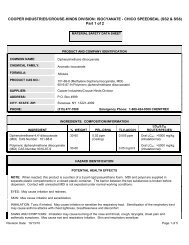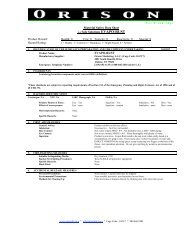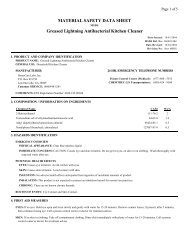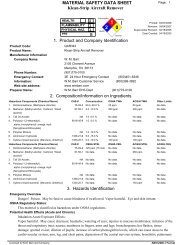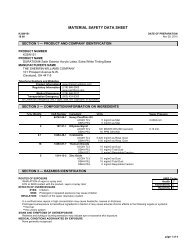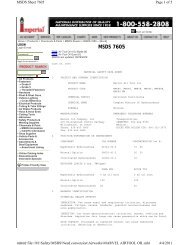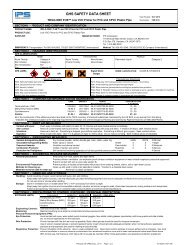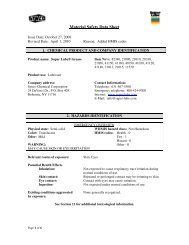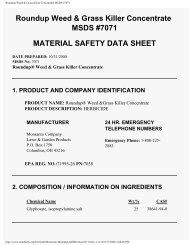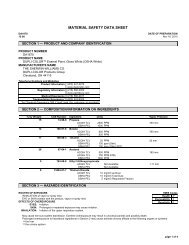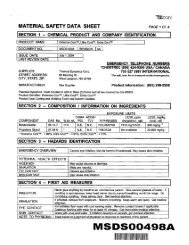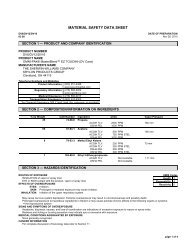MATERIAL SAFETY DATA SHEET - Multi-Craft Contractors, Inc.
MATERIAL SAFETY DATA SHEET - Multi-Craft Contractors, Inc.
MATERIAL SAFETY DATA SHEET - Multi-Craft Contractors, Inc.
Create successful ePaper yourself
Turn your PDF publications into a flip-book with our unique Google optimized e-Paper software.
3. HAZARD IDENTIFICATION (Continued)<br />
INGESTION: Ingestion is not anticipated to be a significant route of occupational overexposure for this product. If ingestion<br />
occurs, refer to Section 4 (First-Aid Measures) and get medical help immediately. If ingestion of this product does occur,<br />
symptoms of such over-exposure can include nausea, vomiting, and other symptoms described for “Inhalation”. Ingestion<br />
can also lead to liver and kidney damage. Ingestion of this product may be fatal.<br />
INJECTION: Injection is not anticipated to be a significant route of over-exposure for this product. If injection does occur (i.e.<br />
through a puncture by an object contaminated with the product), local irritation and swelling can occur. Additional symptoms<br />
may include those described for “Inhalation”.<br />
HEALTH EFFECTS OR RISKS FROM EXPOSURE: An Explanation in Lay Terms.<br />
ACUTE: Over-exposures to this product can be irritating to the eyes, skin, and mucous membranes, and can also cause<br />
central-nervous system effects (dizziness, drowsiness, nausea and headaches). Ingestion of this product, or inhalation of<br />
high concentrations of this product’s vapors, may be fatal.<br />
CHRONIC: Prolonged or repeated skin exposures can lead to dermatitis (dryness, reddening and irritation of the skin).<br />
Tetrahydrofuran, a component of this product, may cause liver and kidney damage after long-term inhalation overexposures.<br />
There is limited evidence from animal studies that Methyl Ethyl Ketone, a component of this product, is a reproductive toxin.<br />
Refer to Section 11 (Toxicological Information) for additional information. A report from the National Toxicology Program<br />
(NTP) has suggested that exposure of mice and rats to Tetrahydrofuran (THF) vapor levels up to 1800 ppm 6 hr/day, 5<br />
days/week for their lifetimes caused an increased incidence of kidney tumors in male rats and liver tumors in female mice. No<br />
evidence of tumors was seen in female rats or male mice. The significance of these findings for human health is unclear at<br />
this time, and may be related to "species specific" effects. Elevated incidences of tumors in humans have not been reported<br />
for THF. The NTP, IARC, or OSHA does not list THF as a carcinogen. One THF vendor (DuPont) has recommended a<br />
reduction in the "acceptable exposure limit" from 200 ppm to 25 ppm, 8 and 12 hour time weighted average and a STEL of<br />
75 ppm.<br />
TARGET ORGANS: Acute: Skin, eyes, respiratory system, central nervous system. Chronic: Liver, kidneys.<br />
PART II What should I do if a hazardous situation occurs<br />
4. FIRST-AID MEASURES<br />
SKIN EXPOSURE: If this product contaminates the skin, immediately begin decontamination with running water. Minimum<br />
flushing is for 15 minutes. Remove exposed or contaminated clothing, taking care not to contaminate eyes. The<br />
contaminated individual must seek medical attention if any adverse effect occurs.<br />
EYE EXPOSURE: If this product's liquid or vapors enter the eyes, open victim's eyes while under gently running water. Use<br />
sufficient force to open eyelids. Have victim "roll" eyes. Minimum flushing is for 15 minutes. The contaminated individual<br />
must seek immediate medical attention.<br />
INHALATION: If vapors, mists, or sprays of this product are inhaled, remove victim to fresh air. If necessary, use artificial<br />
respiration to support vital functions. Remove or cover gross contamination to avoid exposure to rescuers.<br />
INGESTION: If this product is swallowed, CALL PHYSICIAN OR POISON CONTROL CENTER FOR MOST CURRENT<br />
INFORMATION. If professional advice is not available, do not induce vomiting. The contaminated individual should drink<br />
milk, egg whites, or large quantities of water. Never induce vomiting or give diluents (milk or water) to someone who is<br />
unconscious, having convulsions, or unable to swallow.<br />
The contaminated individual must be taken for medical attention, especially if any adverse effect occurs. Rescuers should be<br />
taken for medical attention, if necessary. Take a copy of label and MSDS to health professional with victim.<br />
5. FIRE-FIGHTING MEASURES<br />
The following information is variable, depending on the blend. The following<br />
information is for Tetrahydrofuran, the main solvent component of this product.<br />
NFPA RATING<br />
FLAMMABILITY<br />
FLASH POINT: -17°C (4.1°F)<br />
AUTOIGNITION TEMPERATURE: 321°C (610°F)<br />
FLAMMABLE LIMITS (in air by volume): Lower (LEL): 1.8%<br />
3<br />
Upper (UEL): 11.8%<br />
The following information is for the product.<br />
HEALTH<br />
2 1<br />
REACTIVITY<br />
FIRE EXTINGUISHING <strong>MATERIAL</strong>S:<br />
Water Spray: YES (for cooling only)<br />
Carbon Dioxide: YES<br />
Foam: YES<br />
Dry Chemical: YES<br />
OTHER<br />
Halon: YES Other: Any "B" See Section 16 for Definition of Ratings<br />
LVOC PVC CEMENT PRODUCTS<br />
PAGE 3 OF 11



